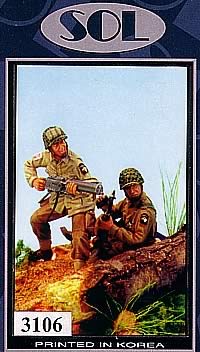|
U.S.
101st Airborne, WWII
|
 |
|
This is a fine pair of airborne figures locked in battle in the hours or days following D-Day. But like the other paratrooper offering from SOL, there are a couple accuracy quirks. First, the reclining soldier is reloading a BAR. It has generally believed among historians, including 101st Airborne historian Mark Bando, that these were not used during D-Day. There was no practical way to break down and case this weapon for jumping into Normandy; it was too long and bulky. However, in 2005 information emerged on Bando's Trigger Time website that there were at least one or two instances of paratroopers armed with BARs. So now the jury is out on this, but it appears unlikely that you'd see a paratrooper with a BAR in the early days of the invasion, unless he appropriated it from an unfortunate infantryman or gliderman who no longer needed its services. Another glitch: they're wearing the wrong boots. Rather than the Corcoran or Goodrich lace-up jump boots, these men sport the M1943 buckle boots with the attached gaiters, which weren't issued until the fall of 1944. By that time, the airborne had discontinued the distinctive M1942 khaki jump uniform switched over to the same M1943 OD coat (the same as worn by ground infantry) for Operation Market Garden. So, if you want to do these guys right, you'll need to pick up a set of DML paratroopers and scavenge their boots (or check my review on the other SOL figure for another option). You might want to add some spare equipment to hese figures as well (shovels, musette bags, etc.). The most eye-catching of the two figures is the soldier in John Wayne pose firing the .30 Browning M1917A1 water-cooled machine gun, which typically required the M1917A1 tripod (the tall triangular tripod found in Tamiya's "U.S. Gun and Mortar Team"). One wonders if this early version of the gun is historically accurate in this context, given that the air-cooled M1919A4 would have been more practical for airdrops (i.e., lighter, and no need for water coolant). A nice touch, however, is the inclusion of a pair of photoetch sights for the gun (one is an extra in case you lose the first). It goes on the rearmost part of the tallest block on top of the receiver. Care must be taken when removing the receiver from the pour plug, so as not to remove the rear trunnion (those two little circles on the bottom plate of the gun). However, the part does not include the front trunnion, where the gun would attach to a tripod for ground use. All in all, you need to consider if you want to switch this gun out with an M1919A4 that you can find in various Tamiya, DML, or Verlinden sets. There are a couple ammo belts included. If you opt to use the kit's gun, you should be aware that "The American Arsenal" states this version fired ammo in cloth belts, as opposed to metal linked belts. The cloth belts would be painted light tan or white. The soldier's additional gear includes a canteen, a Colt .45 pistol, and a pair of hand grenades. The seated BAR gunner has a new magazine of ammo in one hand to reload his weapon. His accessories include a canteen, M3 trench knife, a Colt .45 and a pair of grenades. Care will be needed to separate the BAR from the mold plugs. And make sure you check the contents of the packaging carefully for two little stems that are supposed to be the legs for the BAR bipod, but don't worry if you can't find them or misplace them, as the bipod's not often seen in use. Patches for the 82nd Airborne and U.S. flags are molded into the shoulders and should be removed if you opt for decals or transfers. Both figures have nicely animated faces, and the unaccredited sculptor has done an excellent job posing and crafting these men. Resin is thin in places however, particularly around the rim of the helmets; the machine gunner's helmet has a significant pour tab that will need judicious trimming in order to not destroy the helmet. There's a bit of flash in places but no objectionable seams. The set comes with a resin base and log which are helpful if you're interested in building a simple figure vignette as depicted on the box, but superfluous if you have other diorama interests in mind. In conclusion, this is a tricky little set that needs a few adjustments in accuracy but can build up to visually interesting representations of paratroopers in a combat setting. -tss- |
 |
 |
 |
 |
 |
 |
 |
 |
 |
 |
 |
 |
|
 SOL
SOL